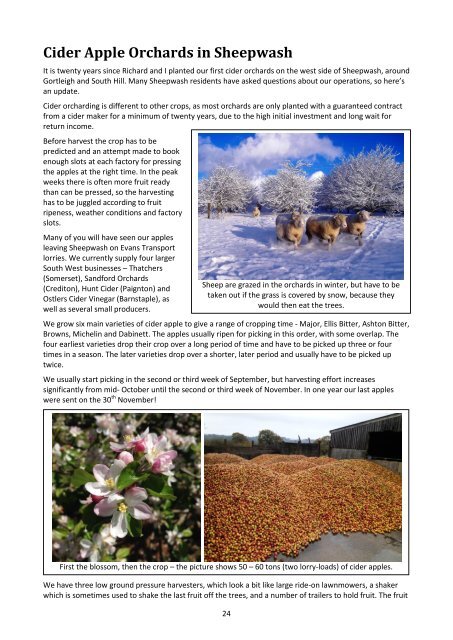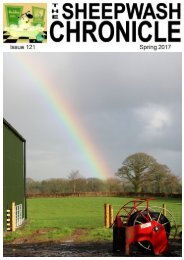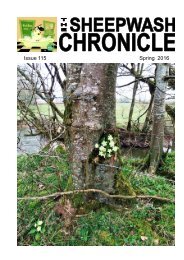Sheepwash Chronicle Christmas 2016 edition
You also want an ePaper? Increase the reach of your titles
YUMPU automatically turns print PDFs into web optimized ePapers that Google loves.
Cider Apple Orchards in <strong>Sheepwash</strong><br />
It is twenty years since Richard and I planted our first cider orchards on the west side of <strong>Sheepwash</strong>, around<br />
Gortleigh and South Hill. Many <strong>Sheepwash</strong> residents have asked questions about our operations, so here’s<br />
an update.<br />
Cider orcharding is different to other crops, as most orchards are only planted with a guaranteed contract<br />
from a cider maker for a minimum of twenty years, due to the high initial investment and long wait for<br />
return income.<br />
Before harvest the crop has to be<br />
predicted and an attempt made to book<br />
enough slots at each factory for pressing<br />
the apples at the right time. In the peak<br />
weeks there is often more fruit ready<br />
than can be pressed, so the harvesting<br />
has to be juggled according to fruit<br />
ripeness, weather conditions and factory<br />
slots.<br />
Many of you will have seen our apples<br />
leaving <strong>Sheepwash</strong> on Evans Transport<br />
lorries. We currently supply four larger<br />
South West businesses – Thatchers<br />
(Somerset), Sandford Orchards<br />
(Crediton), Hunt Cider (Paignton) and<br />
Ostlers Cider Vinegar (Barnstaple), as<br />
well as several small producers.<br />
Sheep are grazed in the orchards in winter, but have to be<br />
taken out if the grass is covered by snow, because they<br />
would then eat the trees.<br />
We grow six main varieties of cider apple to give a range of cropping time - Major, Ellis Bitter, Ashton Bitter,<br />
Browns, Michelin and Dabinett. The apples usually ripen for picking in this order, with some overlap. The<br />
four earliest varieties drop their crop over a long period of time and have to be picked up three or four<br />
times in a season. The later varieties drop over a shorter, later period and usually have to be picked up<br />
twice.<br />
We usually start picking in the second or third week of September, but harvesting effort increases<br />
significantly from mid- October until the second or third week of November. In one year our last apples<br />
were sent on the 30 th November!<br />
First the blossom, then the crop – the picture shows 50 – 60 tons (two lorry-loads) of cider apples.<br />
We have three low ground pressure harvesters, which look a bit like large ride-on lawnmowers, a shaker<br />
which is sometimes used to shake the last fruit off the trees, and a number of trailers to hold fruit. The fruit<br />
24









